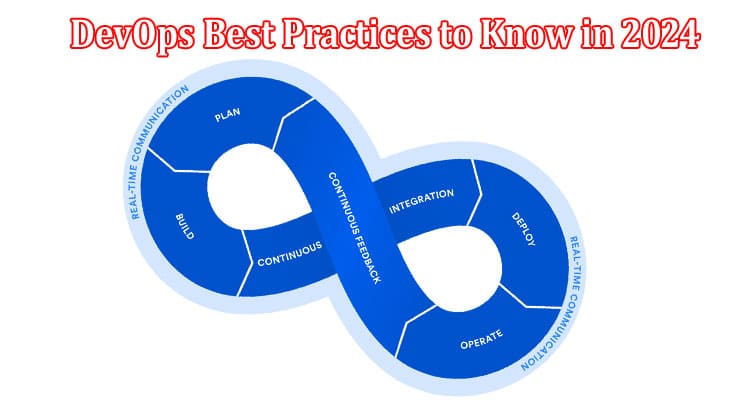What Are the DevOps Best Practices to Know in 2024?
As technology evolves rapidly, staying abreast of the latest best practices in DevOps is essential for software development and IT operations professionals. In 2024, DevOps will continue transforming how organizations deliver software, emphasizing efficiency, collaboration, and automation. With the landscape constantly evolving, it’s crucial to understand and implement the most effective DevOps practices to drive success in today’s dynamic environment. In this blog, we’ll explore the key DevOps best practices shaping the industry in 2024, empowering teams to streamline processes, improve quality, and deliver value to customers more rapidly than ever.
DevOps is a rapidly growing domain reshaping the IT landscape, presenting abundant career opportunities. As organizations worldwide prioritize agility, efficiency, and innovation in software delivery, the demand for skilled DevOps professionals continues to soar. Pursuing a DevOps course equips individuals with in-demand skills such as automation, continuous integration/continuous delivery (CI/CD), and cloud computing, making them invaluable assets in the job market. Moreover, mastering DevOps methodologies fosters collaboration, problem-solving, and a deep understanding of modern IT infrastructures, paving the way for lucrative career paths in roles like DevOps engineers, automation architects, and site reliability engineers.
What is DevOps?
DevOps is like a team sport for software development and IT operations. Imagine you’re building a house: DevOps ensures that everyone from architects to builders works together seamlessly. Instead of each team working separately, DevOps promotes collaboration, communication, and automation throughout the entire process of creating and running software. It’s about breaking down walls between teams to speed up the delivery of new features and fixes while maintaining quality and reliability. By using tools and practices like continuous integration, continuous delivery, and automated testing, DevOps makes the software development and deployment process smoother, more efficient, and less error-prone. Ultimately, DevOps helps businesses deliver better software faster, keeping up with the ever-changing demands of the digital world.
DevOps Best Practices
DevOps practices reflect the idea of continuous improvement and automation. Many practices focus on one or more development cycle phases. These practices include:
Continuous Development: Continuous development is a practice in DevOps where teams continuously work on coding, building, and integrating new features and improvements into the software. It involves breaking down large projects into smaller, manageable tasks, and implementing iterative development cycles. By continuously developing and delivering incremental changes, teams can respond quickly to user feedback, adapt to changing requirements, and deliver value to customers more frequently. Continuous development fosters a culture of collaboration, innovation, and rapid iteration, enabling teams to stay agile and competitive in today’s fast-paced market.
Continuous Testing: Continuous testing is the practice of automating the testing process throughout the software development lifecycle. It involves running tests continuously, from development to deployment, to ensure that each code change is thoroughly tested for functionality, performance, and security before being released into production. By automating tests and running them continuously, teams can identify and fix defects early, maintain code quality, and reduce the risk of introducing bugs into the production environment. Continuous testing enables teams to deliver high-quality software consistently, shorten release cycles, and increase confidence in the reliability of their applications.
Continuous Integration (CI): Continuous integration is a practice in DevOps where developers frequently integrate code changes into a shared repository, typically multiple times a day. Each integration triggers automated build and test processes to validate the changes and ensure that they haven’t introduced any conflicts or errors. CI promotes collaboration among developers, encourages early detection of integration issues, and helps maintain a stable codebase that is always ready for deployment. By adopting CI, teams can improve code quality, reduce integration problems, and accelerate the software development process.
Continuous Delivery: Continuous delivery extends the principles of CI by automating the deployment process to ensure that code changes can be released into production at any time. With continuous delivery, every code change that passes through the CI pipeline is automatically built, tested, and prepared for deployment to a production-like environment. This allows teams to release software updates to customers quickly and confidently, with minimal manual intervention and reduced risk of deployment failures. Continuous delivery enables teams to deliver value to customers more frequently, improve time-to-market, and respond rapidly to changing market demands.
Continuous Deployment (CD): Continuous deployment takes continuous delivery one step further by automatically deploying every code change that passes through the CI pipeline directly into production. This approach eliminates manual intervention in the deployment process, enabling teams to release new features and updates to customers rapidly and frequently. Continuous deployment requires a high degree of automation, robust testing, and confidence in the stability and reliability of the production environment. By adopting CD, teams can achieve faster release cycles, reduce deployment overhead, and increase the agility and competitiveness of their organizations.
Continuous Monitoring: Continuous monitoring involves continuously collecting and analyzing metrics and logs from the software and infrastructure to ensure optimal performance, reliability, and security. By monitoring key performance indicators (KPIs) in real-time, teams can identify and respond to issues quickly, detect anomalies, and optimize system performance and resource utilization. Continuous monitoring provides valuable insights into system behavior, helps maintain service availability, and supports proactive problem-solving and capacity planning. By adopting continuous monitoring, teams can ensure the health and performance of their applications and infrastructure, improve operational efficiency, and enhance the overall user experience.
Infrastructure as Code (IaC): Infrastructure as code is the practice of managing and provisioning infrastructure resources (e.g., servers, networks, storage) through code and automation tools. Instead of manually configuring and managing infrastructure, teams define infrastructure requirements in code using declarative or imperative languages and use automation tools to provision and manage resources programmatically. IaC enables teams to treat infrastructure as software, version control infrastructure configurations, and deploy and manage infrastructure consistently and efficiently across environments. This approach improves agility, repeatability, and scalability, and reduces the risk of configuration drift and human errors. By adopting IaC, teams can accelerate infrastructure provisioning, improve deployment consistency, and enhance the reliability and maintainability of their infrastructure.
Conclusion
Understanding and implementing the latest DevOps best practices are crucial for success in the rapidly evolving technological landscape of 2024. By embracing continuous development, testing, integration, delivery, deployment, monitoring, and infrastructure as code, organizations can achieve greater agility, efficiency, and innovation in software development and operations. Pursuing a DevOps course equips individuals with the skills and knowledge needed to master these practices, enabling them to thrive in the dynamic world of DevOps. Through hands-on experience and practical training, individuals can build the expertise required for a rewarding career in DevOps, driving organizational success and staying ahead in today’s competitive market.




